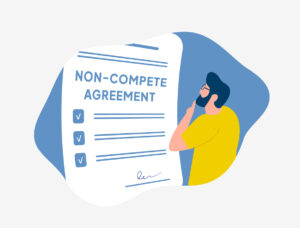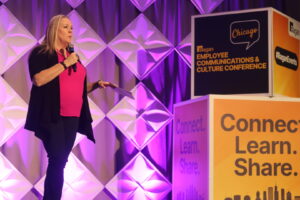Refining your approach to town hall Q&As
How your leadership Q&A can be optimized during town halls to build trust and engage employees in a true dialogue.

In last fall’s Ragan and HarrisX survey, communications leaders and CEOs both rated employee communications as the top way to bring value to their organizations — but comms leaders also said it’s the top function their org needed to improve on.
While there are many forums and touchpoints for directly reaching your employees, none have the potential to engage them quite like a town hall meeting. Since many town halls went virtual in 2020, savvy comms leads have monitored employee engagement around these events to figure out what messages, cadence, formats and overall approaches resonate best with their workforces.
Among the various elements that make up a successful town hall, Q&A time with your leaders is crucial but often under-considered. These forums provide employees with direct access to executives and, when done right, build trust by connecting your leadership’s personality and answers back to the organization’s culture and goals. Q&As are a time to get out in front of concerns, revealing qualitative insights on prevailing employee sentiment while humanizing business decisions through your leaders’ experiences.
We spoke with Valerie Di Maria, principal at the 10 company, to learn more about how leadership Q&A can be optimized during town halls to build trust and engage employees in a true dialogue.
Making time to foster dialogue
Knowing your audience when going into a town hall means knowing what’s really on your employees’ minds. That requires looking at the last post-event town hall survey to learn what worked and what didn’t, then knowing what you want them to understand through that lens. The best way to do this is to use Q&A as an opportunity to foster a dialogue with your employees.
“This is the biggest issue we have with a lot of our clients, said Di Maria. “They say they want questions, but are concerned they won’t have answers or they are more focused on their messages rather than two-way communications, so they never leave enough time for questions.”
Suffice to say, making Q&A an afterthought by squeezing in five minutes at the end isn’t the best way to engage employees. That’s why Di Maria recommends building in time by scheduling at least one run-through and timing it. “If you’re planning a 45-minute conversation with Q&A and everybody’s speaking roles time out to 43 minutes, you’ve got a problem,” she said.
Instead, consider interspersing the Q&A or discussion throughout each speaker segment for at least two or three questions in addition to leaving time for Q&A at the end.
Rehearsing for clarity
When leaders are answering Q&As about the business, the language and focus must reflect the audience’s understanding.
“That’s one of the issues with town hall content,” continued Di Maria, “the feeling that every employee needs to know everything. I’m all for transparency, but if it’s not relevant to my job, why do I need to know that there are project updates? If you feel it’s important for them to know this, extrapolate some best practices that everybody could benefit from.”
Rehearsing so that you’re crisp and understandable also means asking if every employee will understand the terms and phrases you’re using. Di Maria recalled one client in the financial services industry who had a CFO presenting during a town hall using terms that most employees didn’t easily understand.
“Rehearse with somebody who can ask questions like, ‘What do you really mean by that?’ and brainstorm the types of questions that will be asked,” she recommended.
Avoid replying with a qualifying response
While we’ve all replied to someone with a qualifying response like, “That’s a great question,” this knee-jerk reaction often comes off as insincere because it’s usually said to buy time while you’re thinking about your actual answer. Consider coming up with a list of alternative replies if you need the time, such as “Thank you for that question,” “We were just discussing that very issue,” etc.
“It’s also okay to just pause and not comment, then just give them the answer if you have one,” Di Maria said.
The pros and cons of anonymous questions
Leaders often get creative in hopes for more participation during Q&As, and virtual town halls have opened up the opportunity to receive employee questions anonymously.
On the plus side, this lets employees feel free to ask anything, which may empower those who may be too reticent to speak up. But during times of change or uncertainty, this can also leave executives vulnerable to negative or unconstructive comments that weaken the narrative and message you’re trying to convey.
“You have to share rules of engagement so that questions are constructive and not disrespectful,” said Di Maria. “There’s a difference between venting and asking questions that you really want an answer to. The ultimate best scenario is that you build a culture where people feel they can ask what’s on their mind without being anonymous.”
Getting questions in advance
Di Maria advises against planting questions, but believes it’s perfectly OK to select a few people in advance to get the ball rolling on your town hall Q&A. “Tee up a few people who will ask a smart question and prime the pump without being disingenuous again,” she said.
Pre-submitted questions, on the other hand, can be helpful because they force leaders to pay attention to them while preparing. “A lot of times leaders go through the motions of trying to get questions, then still go down their own talk track without acknowledging them,” Di Maria said. “Pre-submitted questions are a great way to see what your employees really want to know, as opposed to what you want to tell them. There’s a middle ground there.”
Don’t make the Q&A the last word
While that Q&A time at the end of your town hall is necessary, weaving opportunities for dialogue throughout also allows leaders to end the town hall in control of the narrative.
But when you’re having a meeting to hear from employees sincerely, closing on a Q&A for the end can end the town hall on a dismissive tone. “You don’t want to tell somebody, ‘that’s not relevant to the discussion today,’” Di Maria said. “You don’t want to shut it down.”
Whether the Q&A is going well or not, leaders must remember that they own the content and have control over what employees remember when they leave the (virtual) room.
“How can you make it easy for me to remember the three things you want me to act on or do or a next step beyond when the next meeting is going to be?” asks Di Maria. “What’s my call to action at the end?”
To learn more about what it takes to deliver impactful employee gatherings, register now for Ragan’s “How to Excecute Outstanding Town Halls” webinar on Feb. 27th.







